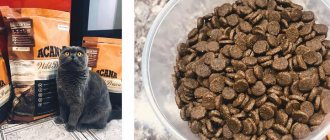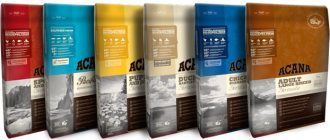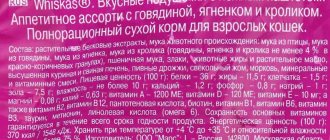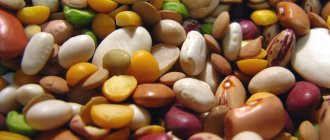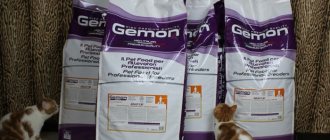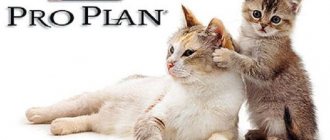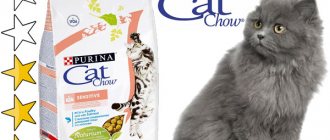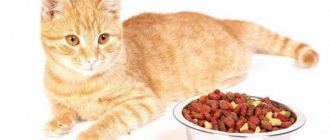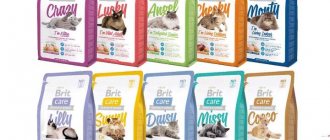Many owners of furry pets think that it would be a good idea to feed their cats natural food. But this is not as simple as it seems at first glance. It is difficult for an ordinary person to calculate the ratio of products in which the cat would receive all the nutrients, minerals and vitamins it needs. This is especially difficult for working people.
Therefore, in order to provide cats with a complete diet, conscientious manufacturers try to create food that would contain the most natural and healthy ingredients, as if the owner was feeding them natural products. One such cat food manufacturer is Champion PetFoods, based in Canada. She creates Acana products, a premium cat food.
Champion Pet Foods Factory
Acana cat food review
The Akan line only contains dry food. This company does not produce wet food. There is no separate Acana food for kittens. Little fluffies are fed the same as adult pets.
Akana stern
For your information! Acana for cats is a holistic food. The “holistic” label on the packaging means that it is made from natural ingredients, is completely balanced and complete, and does not require any additives.
There are only three types of food in the Akana line:
- Acana Grasslands;
- Acana Pacifica;
- Acana Wild Prairie.
Acana Grasslands
Calorie content
Domestic cats that lead a sedentary lifestyle are prone to obesity. Champion Pet Foods experts took this point into account when developing the composition of the finished food. Therefore, the bulk of calories come not from carbohydrates, but from proteins and fats. Accordingly, Akana provides the pet with energy, but not excess fat.
Acana Pacifica
Depending on the type of feed, the calorie content is as follows:
- Acana Grasslands. 4040 kilocalories per kilogram or 485 kilocalories per 120 g. Kilocalories are distributed as follows: 42% - fats, 37% - proteins, 21% - vegetables and fruits;
- Acana Pacifica. Slightly more nutritious, 4080 kilocalories per kilogram or 490 kilocalories per cup of food (120 g). The proportion of kilocalorie distribution is as follows: 22% - vegetables and fruits; 36% - protein; 42% - fat;
- Acana Wild Prairie. The most energy-intensive of all Akan, 4100 kilocalories per kilogram or 492 kcal per 120 g of feed. Contains 22% vegetables and fruits; 36% - protein; 42% fat.
Acana Wild Prairie
Acana range for cats
The Akana cat line is called Regionals - which translated from English means “local”, “regional”. The manufacturer reports that the raw materials for the manufacture of these products are purchased from local, Canadian farms and fisheries, and on its website it details all suppliers. All foods in this line are complete, i.e. Intended for everyday feeding of cats of all breeds and age categories.
Acana feed sold in the Russian Federation differs from feed sold in the USA and Canada in terms of its range. For example, Acana Meadowland and Appalachian Ranch cat food are not sold in Russia. The American food based on fisheries products is called Wild Atlantic, and the one sold in Russia is called Pacifica (they also differ in ingredients).
The difference in the Russian and American Acana assortment can be explained by the fact that the food supplied to Russia is manufactured at the NorthStar factory, Canada, while the American assortment is produced at the DogStar factory, Kentucky, USA, from local ingredients and exclusively for the American market.
Composition of Acana feed
Gemon (food for cats and kittens): description and composition
In each of the three products, 75% is meat or fish, as well as offal. There is no need to be afraid of the presence of a liver, heart and kidneys; they are very important for cats. After all, in nature, small predators eat their prey whole.
Note! A quarter of the composition is vegetables and fruits, as well as herbal supplements.
Akana does not use potatoes or grains as additives. The raw materials used in production are not genetically modified.
Acana for cats contains an appropriate balance of taurine, omega-3 unsaturated fatty acids, fiber, fat, protein, calcium, phosphorus, ash, omega 3/6 fatty acids, and magnesium that are beneficial for cats.
The following types of meat and offal are used for production:
- turkey;
- duck;
- lamb;
- lamb fat;
- raw lamb tripe;
- liver, heart and kidneys of duck;
- dried lamb cartilage;
- lamb liver;
- chicken meat;
- chicken offal;
- turkey and chicken giblets;
- chicken fat.
For your information! Beef is difficult for a cat's gastrointestinal tract to digest.
Herbal Ingredients
Herbal composition:
- whole legumes: beans, red and green lentils, yellow and green peas;
- alfalfa as a source of fiber, protein, iron, magnesium;
- pumpkin to improve digestion;
- brown algae - supplier of selenium, iodine, magnesium, zinc, manganese;
- cranberry as one of the means for the prevention of urolithiasis;
- turnip greens, containing a lot of fiber;
- blueberries to improve vision;
- lavender, the smell of which attracts cats;
- milk thistle to prevent liver disease;
- marshmallow root, which has an anti-inflammatory and enveloping effect;
- Turmeric improves the secretion of bile, which is necessary for quality digestion of food.
Alfalfa - a source of magnesium
Supplements
Acana Holistic for Cats contains the following beneficial supplements:
- dry fermentation product Enterococcus faecium - beneficial bacteria that help digestion, they are part of the natural microflora of the cat's intestines;
- choline chloride 1000 mg - a derivative of vitamin B4, which has certain benefits for the cat's liver;
- zinc improves the condition of the skin and coat, has an anti-inflammatory effect;
- Copper is important for the formation of bone tissue and cartilage.
Important! Each package contains the recommended daily intake of Akana food for kittens and adult cats. If the cat has to be sterilized or is already sterilized, then you should give preference to Acana Grasslands, where there is the least amount of fish that is harmful to such pets.
How much should you give your cat?
If the cat has previously eaten other food, then Acana should be introduced gradually, adding 10-20% to the pet’s standard menu. The full transition takes place in 7 days.
To avoid overeating, it is necessary to monitor the daily intake of the product, and the animal should always have access to water.
Manufacturers do not recommend combining several Acana varieties, as this is fraught with gastrointestinal disorders. You need to choose one flavor that your pet will like most. Three meals a day at equal intervals are shown. It is important to monitor portion sizes, as overeating is fraught with complications for the gastrointestinal tract. Serving size is calculated based on the weight of the animal. The standard volume varies from 20 to 100 g per day. There should be clean water next to the food bowl. If your pet has scabies, rashes, or the condition of the fur has worsened, then you need to switch to another product.
Comparison table: different types of Acana food
| Name of food | Main Ingredients | Calorie content | Purpose | Price |
| Acana Grasslands | Northern pike, turkey, lamb, duck, eggs | 4040 kcal/kg | For all ages and breeds (including Maine Coons). The dosage is indicated on the package | From 370 to 3710 rub. |
| Acana Pacifica | Flounder, Pacific sardine, silver hake, herring, perch | 4080 kcal/kg | For all ages and breeds (including Maine Coons). The dosage is indicated on the package | From 370 to 3710 rub. |
| Acana Wild Prairie | Turkey, chicken, rainbow trout, northern walleye, eggs, | 4100 kcal/kg | For all ages and breeds (including Maine Coons). The dosage is indicated on the package | From 370 to 3710 rub.* |
Monge: food for cats and kittens, composition Monge
Note! There is no official opinion from veterinarians regarding Akan cat food, as well as regarding other similar products. But many well-known nurseries give preference to this brand.
How much and when to feed your cat
Experts recommend feeding domestic cats three times a day. It is optimal if meals take place in the morning, mid-day and evening. It is best if the interval between feedings is 8-12 hours. The amount of food consumed is adjusted individually depending on the age and condition of the animal.
It is necessary to ensure that the cat does not overeat.
At home, a pet can easily become obese, which will negatively affect not only the quality of its life, but also its duration. To control your pet's weight, you don't have to weigh it regularly. It is enough to pay attention to his physical condition. If, when stroking a pet, its bones can be easily felt, the cat’s weight is within normal limits.
Excess weight is unacceptable
When feeding dry food, it is especially important to ensure that the water in the bowl is fresh and clean. A cat whose diet consists of ready-made snacks drinks more and more often than those who eat natural food.
For cats weighing two to four kilograms, a handful of food weighing 50 grams is considered a normal portion. Cats from four to six kilograms consume about 75 grams of food. If a murka weighs more than seven kilograms, then its portion is 100 grams of food.
Advantages and disadvantages
Akana cat food, like any product, has its advantages and disadvantages.
Pros of food
Our brand: food for cats and kittens, composition
The undeniable advantages include:
- use of high-quality meat and fish ingredients;
- absence of genetically modified products;
- absence of cereals and potatoes;
- the presence of beneficial bacteria and a vitamin-mineral complex;
- the composition is described in detail;
- well-designed feed dosage;
- It is easy to order from an online pet store, since this food is one of the most common.
Cons of food
The disadvantages include the following:
- price;
- difficulties in purchasing, since it is not sold in ordinary pet stores;
- contains legumes. Some veterinarians believe that cats and dogs should not eat legumes of any kind. They are not absorbed by the cat's body, trigger fermentation processes in the intestines, and lead to flatulence. May cause intestinal colic;
- Another controversial ingredient is collard greens. White cabbage is not a clear choice for cats; there are different opinions about leafy cabbage (kale);
- apples and pears, like all fruits, can also cause increased gas formation;
- Alfalfa, which is so popular in feed, can disrupt hormonal levels due to the large amount of phytoestrogens;
- spinach increases the risk of urolithiasis;
- For light-colored cats participating in exhibitions, brown algae is not recommended, as it gives a yellowish color to the coat (most likely due to the large amount of iodine).
Note! It should be borne in mind that not very healthy ingredients are contained either in processed form or in small quantities.
What changes in a cat's body after sterilization?
The fact that the animal ceases to experience sexual heat (in the case of complete and proper sterilization) and loses the ability to reproduce is quite obvious; in fact, it is in most cases the purpose of the operation. However, less obvious changes also occur in the cat’s body and behavior, which cannot fail to attract the attention of loving owners.
Suppression of reproductive function leads to inevitable hormonal changes: in cats, the production of estrogen gradually stops, in cats - testosterone. Normally, sex hormones speed up metabolism, suppress appetite, and affect the aggression and activity of animals. Accordingly, their absence may lead to the fact that after surgery your pet will ask for food more often, spend more time in quiet contemplation instead of searching, and burn calories less quickly. As a result, the risk of overfeeding increases many times over, which, in turn, leads to such problems as obesity, diabetes, urolithiasis, heart failure and others.
Is it possible to avoid weight gain in spayed and neutered cats? Undoubtedly. And the first condition is not to follow the wishes of the pet, strictly observing the daily feeding norms. The second is to encourage him to play, move, and provide an additional source of interest other than food. Finally, the third thing, but not least, is to choose the optimal diet for a sterilized cat. Let's look at this in more detail.
How much does it cost and where to buy Akana food?
This brand is a premium one, so the food cannot be cheap. Its price starts from 370 rubles. per 340 gram pack. The most expensive package is 5.4 kg - from 3,710 rubles.
This brand of food is available in the following retail pet store chains:
- Beethoven;
- Four paws;
- CATFISH;
- Vetlek;
- Doberman;
- Markvet;
- ZooGallery;
- ZooLakki;
- Zoo booth;
- Grasshopper;
- Dinosaur;
- Pet;
- Feed rate;
- Old Farm;
- Pet market.
From online stores it is offered:
- Old Farm;
- Petshop.ru
Budget alternatives to Acana food
On the one hand, there is nothing reprehensible in the owner’s desire to choose cheaper food, because Acana is not the cheapest delicacy. However, you should not choose analogues of this food from economy-class products - there are obvious differences in quality. And even if the owner is satisfied with the composition of cheap food, it is unknown how the cat’s body will accept such a replacement.
When choosing a budget alternative to Acana food, it is useful to familiarize yourself with the food rating:
| Name | Class | Compound | Type of feed | Price |
| Pro Plan | Premium |
|
| from 290 rubles per 0.5 kg. |
| Pro Nature | Premium |
|
| from 800 rubles for 1.5 kg. |
| Hill's (Science Plan) | Super premium |
|
| from 270 rubles per 0.5 kg. |
| Innova Evo | Holistic |
|
| from 995 rubles for 1.5 kg. |
| Eagle Pack Holistic | Holistic |
|
| from 360 rubles per 0.5 kg. |
Alternative
The best replacement would be food from the same manufacturer - Orijen. This line is represented by the following products:
Orijen Tundra, which includes:
- meat of wild boar, duck, deer, goat and their offal;
- mutton and lamb;
- fish: arctic char, rainbow trout, mackerel, sardine, blue whiting, cod;
- legumes: green and red lentils, chickpeas, yellow and green peas, beans;
- fruits and berries: apples, pears, blueberries, cranberries, rose hips, juniper;
- turmeric;
- vegetables: zucchini, pumpkin, kale (leaf), parsnips, carrots, spinach, beet and turnip tops;
- brown algae;
- roots: marshmallow, sarsaparilla, chicory.
Note! This food is for all breeds and ages.
Orijen Fit & Trim is available for overweight cats. Its composition:
- chick;
- eggs;
- mackerel;
- turkey and its offal;
- Pacific hake;
- flounder;
- pollock;
- sardine;
- herring;
- lavender flowers;
- peas, chickpeas, lentils, beans, navy beans;
- berries of serviceberry.
Orijen food is a good alternative to Akana food
Thus, Akana food, although not without certain drawbacks, is much better suited for feeding domestic cats than the cheap options sold in every store. It is available for purchase in many stores, but is quite expensive.
*Prices are as of October 2021.
Feed class and composition
Many cat owners are confident that the Acana food class is Premium. But the company’s official website classifies its products as holistic, a new class of food. In other words, such a product includes only natural ingredients:
- meat (beef, veal, lamb, rabbit);
- poultry meat;
- sea and freshwater fish;
- offal;
- vegetables are sources of fiber and carbohydrates;
- fruits and berries (help normalize the acidity of urine, reduce the risk of developing genitourinary diseases);
- seaweed (has a beneficial effect on digestion);
- medicinal herbs (promote the removal of bile, give the pet vigor).
Acana dry food is considered hypoallergenic and causes virtually no reactions in cats. Moreover, the components in the product help remove toxins from the animal’s intestines, reduce the pH of urine, and also improve digestion, since the food contains phytocomponents. The product is well absorbed and helps keep your pet's coat and skin in perfect condition.
